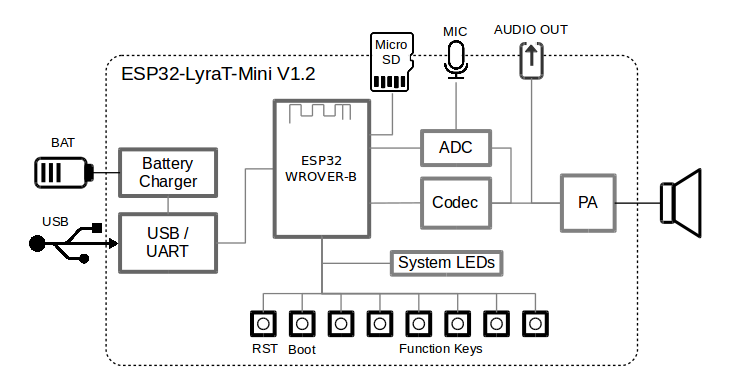ESP32-LyraT-Mini V1.2 Getting Started Guide¶
This guide provides users with functional descriptions, configuration options for ESP32-LyraT-Mini V1.2 audio development board, as well as how to get started with the ESP32-LyraT board.
The ESP32-LyraT is a hardware platform designed for the dual-core ESP32 audio applications, e.g., Wi-Fi or BT audio speakers, speech-based remote controllers, connected smart-home appliances with one or more audio functionality, etc.
The ESP32-LyraT-Mini is a mono audio board. If you are looking for a stereo audio board, check ESP32-LyraT V4.3 Getting Started Guide.
What You Need¶
- ESP32-LyraT-Mini V1.2 board
- 4-ohm speaker with Dupont female jumper wires or headphones with a 3.5 mm jack
- Two Micro-USB 2.0 cables, Type A to Micro B
- PC loaded with Windows, Linux or Mac OS
Optional components
- Micro SD-card
- Li-ion Battery
If you like to start using this board right now, go directly to section Start Application Development.
Overview¶
The ESP32-LyraT-Mini V1.2 is an audio development board produced by Espressif built around ESP32. It is intended for audio applications, by providing hardware for audio processing and additional RAM on top of what is already on-board of the ESP32 chip. The specific hardware includes:
- ESP32-WROVER-B module
- Audio codec chip
- ADC chip
- Microphone on board
- Audio output
- 1 x 3-watt speaker output
- MicroSD card slot (1 line)
- Eight keys
- Two system LEDs
- JTAG and UART test points
- Integrated USB-UART Bridge Chip
- Li-ion Battery-Charge Management
The block diagram below presents main components of the ESP32-LyraT-Mini and interconnections between components.

ESP32-LyraT-Mini Block Diagram
Components¶
The following list and figure describe key components, interfaces and controls of the ESP32-LyraT-Mini used in this guide. For detailed technical documentation of this board, please refer to ESP32-LyraT-Mini V1.2 Hardware Reference and ESP32-LyraT-Mini V1.2 schematic (PDF). The list below provides description starting from the picture’s top right corner and going clockwise.
- Audio Codec Chip
- The audio codec chip, ES8311, is a low power mono audio codec. It consists of 1-channel ADC, 1-channel DAC, low noise pre-amplifier, headphone driver, digital sound effects, analog mixing and gain functions. It is interfaced with ESP32-WROVER-B Module over I2S and I2C buses to provide audio processing in hardware independently from the audio application.
- Audio Output
- Output socket to connect headphones with a 3.5 mm stereo jack. (Please note that the board outputs a mono signal)
- Speaker Output
- Output socket to connect 4 ohm speaker. The pins have a standard 2.54 mm / 0.1” pitch.
- USB-UART Port
- Functions as the communication interface between a PC and the ESP32.
- USB Power Port
- Provides the power supply for the board.
- Standby / Charging LEDs
- The Standby green LED indicates that power has been applied to the USB Power Port. The Charging red LED indicates that a battery connected to the Battery Socket is being charged.
- Power On Switch
- Power on/off knob: toggling it to the top powers the board on; toggling it to the down powers the board off.
- Power On LED
- Red LED indicating that Power On Switch is turned on.
- ESP32-WROVER-B Module
- The ESP32-WROVER-B module contains ESP32 chip to provide Wi-Fi / BT connectivity and data processing power as well as integrates 32 Mbit SPI flash and 64 Mbit PSRAM for flexible data storage.
Start Application Development¶
Before powering up the ESP32-LyraT-Mini, please make sure that the board has been received in good condition with no obvious signs of damage.
Initial Setup¶
Prepare the board for loading of the first sample application:
- Connect 4-ohm speaker to the Speaker Output. Connecting headphones to the Audio Output is an option.
- Plug in the Micro-USB cables to the PC and to both USB ports of the ESP32-LyraT-Mini.
- The Standby LED (green) should turn on. Assuming that a battery is not connected, the Charging LED (red) will blink every couple of seconds.
- Toggle top the Power On Switch.
- The red Power On LED should turn on.
If this is what you see on the LEDs, the board should be ready for application upload. Now prepare the PC by loading and configuring development tools what is discussed in the next section.
Develop Applications¶
If the ESP32 LyraT is initially set up and checked, you can proceed with preparation of the development tools. Go to section Get Started, which will walk you through the following steps:
- Set up ESP-IDF in your PC that provides a common framework to develop applications for the ESP32 in C language;
- Get ESP-ADF to have the API specific for the audio applications;
- Setup Path to ESP-ADF to make the framework aware of the audio specific API;
- Start a Project that will provide a sample audio application for the ESP32-LyraT-Mini board;
- Connect and Configure to prepare the application for loading;
- Build, Flash and Monitor this will finally run the application and play some music.
